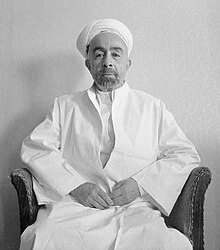Abdullah I of Jordan
| Abdullah I | |
|---|---|
 |
|
| King of Jordan | |
| Reign | 25 May 1946 – 20 July 1951 |
| Predecessor | Office established (formerly Emir of Transjordan) |
| Successor | Talal |
| Emir of Transjordan | |
| Reign | 1 April 1921 – 25 May 1946 |
| Predecessor | Office Established |
| Successor | Office changed to King of Jordan |
| Born | February 1882 Mecca, Ottoman Empire |
| Died | 20 July 1951 (aged 69) Al Aqsa Mosque, Jerusalem |
| Burial | Raghadan Palace |
| Consort Junior wives |
Musbah bint Nasser Suzdil Khanum Nahda bint Uman |
| Issue |
Princess Haya Talal I Prince Naif Princess Munira Princess Maqbula Princess Naifeh |
| House | Hashemite |
| Father | Hussein bin Ali |
| Mother | Abdiyya bint Abdullah |
| Religion | Sunni Islam |
|
Styles of King Abdullah I of Jordan formerly Emir of Transjordan |
|
|---|---|
 |
|
| Reference style | His Majesty |
| Spoken style | Your Majesty |
| Alternative style | Sir |
Abdullah I bin al-Hussein, King of Jordan (Arabic: عبد الله الأول بن الحسين, Abd Allāh ibn al-Husayn, February 1882 – 20 July 1951), born in Mecca, Hejaz, Ottoman Empire (in modern-day Saudi Arabia), was the second of three sons of Hussein bin Ali, Sharif and Emir of Mecca and his first wife Abdiyya bint Abdullah (d. 1886).
He was educated in Constantinople and Hejaz. From 1909 to 1914, Abdullah sat in the Ottoman legislature, as deputy for Mecca, but allied with Britain during World War I. Between 1916 and 1918, working with the British guerrilla leader T. E. Lawrence, he played a key role as architect and planner of the Great Arab Revolt against Ottoman rule, leading guerrilla raids on garrisons. He was the ruler of Transjordan and its successor state, Jordan, from 1921 to 1951—first as Emir under a British Mandate from 1921 to 1946, then as King of an independent nation from 1946 until his assassination in 1951.
In 1910, Abdullah persuaded his father to stand, successfully, for Grand Sharif of Mecca, a post for which Hussein acquired British support. In the following year he became deputy for Mecca in the parliament established by the Young Turks, acting as an intermediary between his father and the Ottoman government. In 1914, Abdullah paid a clandestine visit to Cairo to meet Lord Kitchener to seek British support for his father's ambitions in Arabia.
Abdullah maintained contact with the British throughout the First World War and in 1915 encouraged his father to enter into correspondence with Sir Henry McMahon, British high commissioner in Egypt, about Arab independence from Turkish rule. (see McMahon-Hussein Correspondence). This correspondence in turn led to the Arab Revolt against the Ottomans. During the Arab Revolt of 1916–18, Abdullah commanded the Arab Eastern Army. Abdullah began his role in the Revolt by attacking the Ottoman garrison at Ta’if on 10 June 1916. The garrison consisted of 3,000 men with ten 75-mm Krupp guns. Abdullah led a force of 5,000 tribesmen but they did not have the weapons or discipline for a full attack. Instead he laid siege to town. In July he received reinforcements from Egypt in the form of howitzer batteries manned by Egyptian personnel. He then joined the siege of Medina commanding a force of 4,000 men based to the east and north-east of the town. In early 1917, Abdullah ambushed an Ottoman convoy in the desert, and captured £20,000 worth of gold coins that were intended to bribe the Bedouin into loyalty to the Sultan. In August 1917, Abdullah worked closely with the French Captain Muhammand Ould Ali Raho in sabotaging the Hejaz Railway. Abdullah's relations with the British Captain T. E. Lawrence were not good, and as a result, Lawrence spent most of his time in the Hejaz serving with Abdullah's brother Faisal who commanded the Arab Northern Army.
...
Wikipedia
